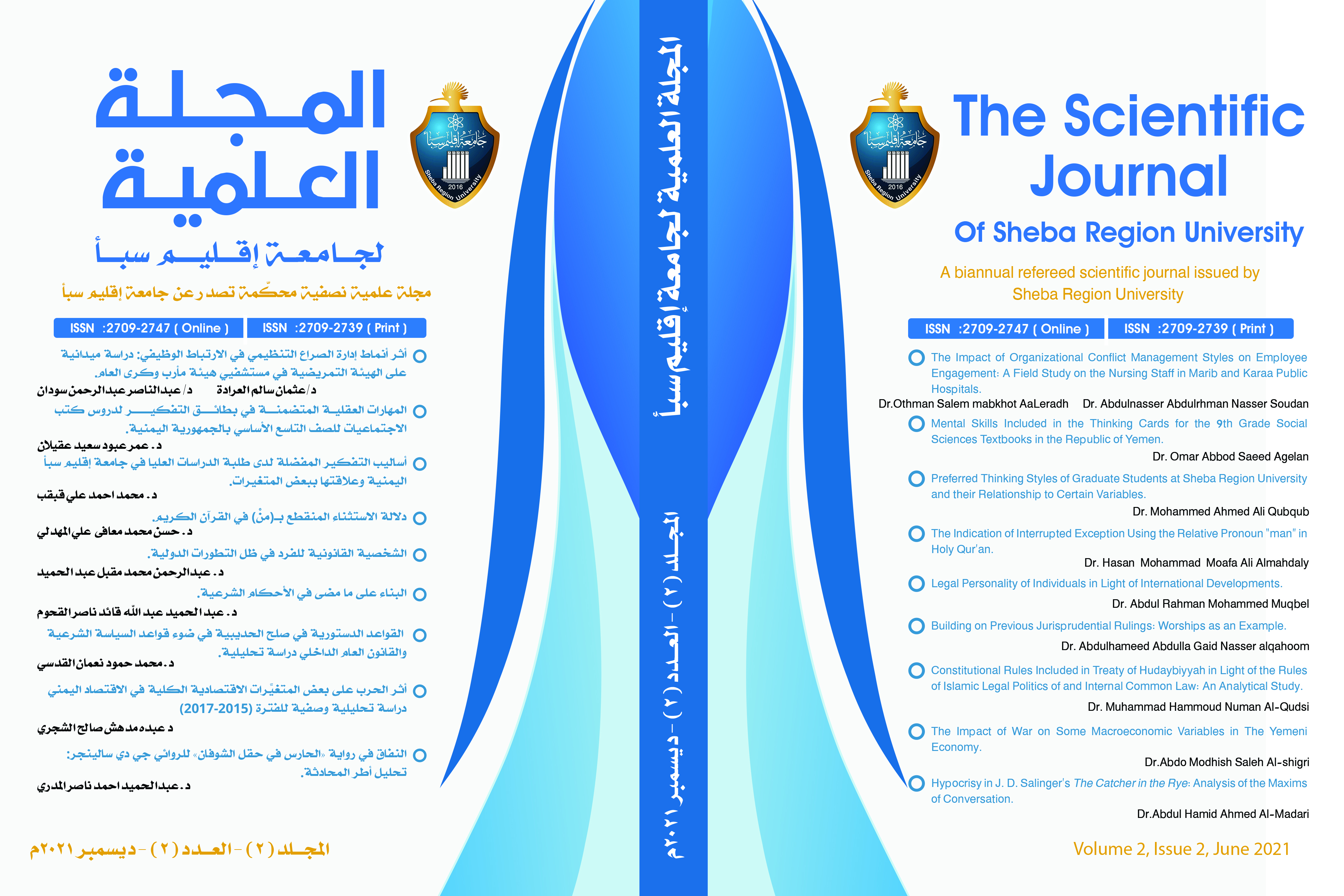القواعد الدستورية في صلح الحديبية في ضوء قواعد السياسة الشرعية والقانون العام الداخلي دراسة تحليلية.
Constitutional Rules Included in Treaty of Hudaybiyyah in Light of the Rules of Islamic Legal Politics of and Internal Common Law: An Analytical Study
DOI:
https://doi.org/10.54582/TSJ.2.2.7الكلمات المفتاحية:
القواعد، صلح، الحديبية، القانون، rules، Hudaybiyyah، constitutionalالملخص
هدفت هذه الدراسة إلى إظهار القواعد الدستورية التي تضمنها صلح الحديبة سواء أكانت تلك القواعد قواعد دستورية أساسية، أم في باب الحقوق والحريات، وقد استخدم الباحث منهجين من مناهج البحث العلمي، المنهج التاريخي في تتبع الروايات الواردة في الصلح من صحاح السنة وكتب التفسير والسير والتاريخ والمغازي، والمنهج التحليلي من خلال دراسة تلك الروايات من مصادرها الأصلية وتحليليها وتفسيرها واستنباط ما تضمنته من قواعد في ضوء قواعد السياسة الشرعية والقانون العام الداخلي، وقد توصلت الدراسة إلى أنَّ الصلح قد اشتمل على العديد من القواعد الدستورية المهمة والمتمثلة بمبدأ المشروعية، ومبدأ الشورى، والأخذ برأي الأغلبية، وكذا حرية العقيدة، وحرية التعبير، وحقوق المرأة السياسية، والتي كانت ولا تزال قيمًا إسلامية سامية تمثل الأساس المتين، والنهج القويم في بناء الدولة المسلمة في زمن الرسول وبعده في الوقت التي كانت المجتمعات غير المسلمة ترسف تحت وطأة من التسلط والاستفراد والتجبر، وكان فيه قول الحاكم الذي لا يعلو عليه قول هو القانون الواجب النفاذ في مواجهة الجميع، وبالمقابل فإنَّ الشعوب غير المسلمة لم تصل إلى إقرار تلك القواعد إلا بعد كفاح طويل، ومع ذلك فلا يزال الأمر غير مستقر، بخلاف الأمر في النظام الإسلامي فقد اتضحت معالمه وبانت حدوده، وتجلت أحكامه مع ظهور الدولة المسلمة في زمن النبي وبنصوص صحيحة صريحة، وهذا دليلٌ واضح أنَّ الدولة المسلمة وليدة القانون الإسلامي وصنيعته.
This study aimed at exhibiting the constitutional rules included in the Treaty of Hudaybiyyah. It also investigated whether these rules are fundamental constitutional rules, or just items in the section of rights and freedom. The historical and the analytical approaches were adopted in this study. The historical approach is used to track the narrations introduced in Sihah books (the Six Canonical Books of Hadith), Tafsir books, Seerah, history, and Maghazi. The research also used the analytical approach to study and analyze these narrations from their original sources. It is also used to interpret such narrations and deduce their inclusion of the rules in the light of the rules of Islamic legal politics and internal common law. The study concluded that the Treaty included many important constitutional rules, namely the principle of legitimacy, the principle of shura, and the majority opinion taking, as well as freedom of belief, freedom of expression, and women’s political rights. All those have been high Islamic values that represent the solid and strong foundation of building the Muslim State in the time of the Prophet and what followed. At that time, non-Muslim societies were being burdened by domination, isolation and tyranny, and the ruler’s word was the one to be heard and obeyed and the law to be enforced. Non-Muslim people reached the adoption of those rules after a long struggle and that adoption remained unstable in their societies. In the case of the Islamic administration, however, it has become clear and its borders have been defined, with the emergence of the Muslim state in the time of the Prophet in explicitly correct texts. Therefore, it is quite clear that the Muslim State is the product of Islamic Law and its creation.
التنزيلات
منشور
كيفية الاقتباس
إصدار
القسم
الرخصة
حقوق النشر والترخيص
تنشر هذه المجلة جميع المواد العلمية بموجب رخصة Creative Commons Attribution 4.0 International (CC BY 4.0) ، والتي تمنحك الصلاحيات التالية:
لك مطلق الحرية في:
- المشاركة — نسخ وتوزيع ونقل العمل لأي وسط أو شكل. لأي غرض، بما في ذلك تجارياً.
- التعديل — المزج، التحويل، والإضافة على العمل. لأي غرض، بما في ذلك تجارياً.
- لا يمكن للمرخِّص إلغاء هذه الصلاحيات طالما اتبعت شروط الرخصة.
بموجب الشروط التالية:
- نَسب المُصنَّف — يجب عليك نَسب العمل لصاحبه بطريقة مناسبة ، وتوفير رابط للترخيص، وبيان إذا ما قد أُجريت أي تعديلات على العمل . يمكنك القيام بهذا بأي طريقة مناسبة، ولكن على ألا يتم ذلك بطريقة توحي بأن المؤلف أو المرخِّص مؤيد لك أو لعملك.
- منع القيود الإضافية — يجب عليك ألا تطبق أي شروط قانونية أو تدابير تكنولوجية تقيد الآخرين من ممارسة الصلاحيات التي تسمح بها الرخصة.
ملاحظات:
لا يتوجب عليك الامتثال لشروط الرخصة مع العناصر الخاضعة للملك العام في المصنف أو إذا كان استخدامك ضمن نطاق الاستثناءات أو الصلاحيات .
بدون ضمانات. قد لا توفر لك الرخصة كل الصلاحيات التي تحتاجها لغرض معين. فمثلاً، الحقوق الأخرى مثل الشهرة، الخصوصية، أو الحقوق المعنوية قد تحد من استخدامك المُصنَّف.











